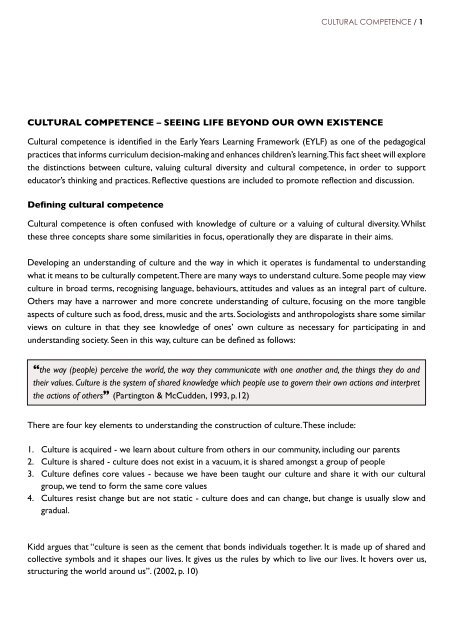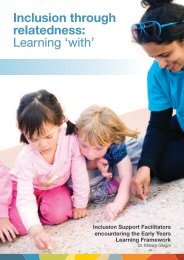Download Cultural Competence - Children's Services Central
Download Cultural Competence - Children's Services Central
Download Cultural Competence - Children's Services Central
You also want an ePaper? Increase the reach of your titles
YUMPU automatically turns print PDFs into web optimized ePapers that Google loves.
CULTURAL COMPETENCE / 1<br />
CULTURAL COMPETENCE – SEEING LIFE BEYOND OUR OWN EXISTENCE<br />
<strong>Cultural</strong> competence is identified in the Early Years Learning Framework (EYLF) as one of the pedagogical<br />
practices that informs curriculum decision-making and enhances children’s learning. This fact sheet will explore<br />
the distinctions between culture, valuing cultural diversity and cultural competence, in order to support<br />
educator’s thinking and practices. Reflective questions are included to promote reflection and discussion.<br />
Defining cultural competence<br />
<strong>Cultural</strong> competence is often confused with knowledge of culture or a valuing of cultural diversity. Whilst<br />
these three concepts share some similarities in focus, operationally they are disparate in their aims.<br />
Developing an understanding of culture and the way in which it operates is fundamental to understanding<br />
what it means to be culturally competent. There are many ways to understand culture. Some people may view<br />
culture in broad terms, recognising language, behaviours, attitudes and values as an integral part of culture.<br />
Others may have a narrower and more concrete understanding of culture, focusing on the more tangible<br />
aspects of culture such as food, dress, music and the arts. Sociologists and anthropologists share some similar<br />
views on culture in that they see knowledge of ones’ own culture as necessary for participating in and<br />
understanding society. Seen in this way, culture can be defined as follows:<br />
There are four key elements to understanding the construction of culture. These include:<br />
1.<br />
2.<br />
3.<br />
4.<br />
“the way (people) perceive the world, the way they communicate with one another and, the things they do and<br />
their values. Culture is the system of shared knowledge which people use to govern their own actions and interpret<br />
the actions of others” (Partington & McCudden, 1993, p.12)<br />
Culture is acquired - we learn about culture from others in our community, including our parents<br />
Culture is shared - culture does not exist in a vacuum, it is shared amongst a group of people<br />
Culture defines core values - because we have been taught our culture and share it with our cultural<br />
group, we tend to form the same core values<br />
Cultures resist change but are not static - culture does and can change, but change is usually slow and<br />
gradual.<br />
Kidd argues that “culture is seen as the cement that bonds individuals together. It is made up of shared and<br />
collective symbols and it shapes our lives. It gives us the rules by which to live our lives. It hovers over us,<br />
structuring the world around us”. (2002, p. 10)




